Definition, Graph, Properties, Solved Example Problems - The Tangent Function and the Inverse Tangent Function | 12th Mathematics : UNIT 4 : Inverse Trigonometric Functions
Chapter: 12th Mathematics : UNIT 4 : Inverse Trigonometric Functions
The Tangent Function and the Inverse Tangent Function
The Tangent Function and the Inverse Tangent Function
We know that the tangent function y = tan x is
used to find heights or distances, such as the height of a building, mountain,
or flagpole. The domain of y = tan x = sinx/cosx does not include
values of x , which make the denominator
zero. So, the
tangent function is
not defined at x = …, -3π/2, -π/2, π/2, 3π/2, ….
Thus, the domain of the tangent function y = tan x is  and the range is (−∞, ∞) . The tangent function y =
tan x has period π.
and the range is (−∞, ∞) . The tangent function y =
tan x has period π.
1. The graph of tangent function
Graph of the tangent function is useful to find the values of the
function over the repeated period of intervals. The tangent function is odd and
hence the graph of y = tan x is symmetric with respect to the origin.
Since the period of tangent function is π , we need to determine the
graph over some interval of length π . Let us consider the interval (-π/2, π/2)
and construct the following table to draw the graph of y = tan x, x
∈ (-π/2, π/2).

Now, plot the points and connect them with a smooth curve for a
partial graph of y = tan x , where – π/2 ≤ x ≤
π/2. If x is close to
π/2 but remains less than π/2 , the sin x will be close to 1 and cos x
will be positive and close to 0. So, as x approaches to π/2 , the
ratio sin x/cos x is positive and large and thus
approaching to ∞.
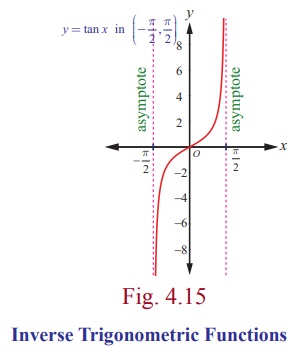
Therefore, the line x = π/2 is a vertical
asymptote to the graph. Similarly, if x is approaching to –π/2,
the ratio sin x/cos x is negative and large in magnitude and
thus, approaching to -∞. So, the line x= - π/2 is
also a vertical asymptote to the graph. Hence, we get a branch of the graph of y
= tan x for -π/2 < x < -π/2 as shown in the Fig 4.15. The
interval (-π/2, π/2) is called the principal domain of y = tan x.
Since the tangent function is defined for all real numbers
except at  , and is increasing , we have vertical asymptotes
, and is increasing , we have vertical asymptotes  .
.
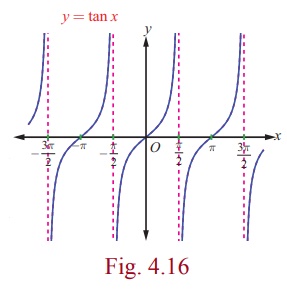
As branches of y = tan x are symmetric with
respect to x = nπ , n ∈ Z , the entire graph of
y = tan x is shown in Fig. 4.16.
Note
From the graph, it is seen that y = tan x is
positive for 0 < x < π/2 and π < x < 3π/2
; y = tan x is negative for π/2 < x < π
and 3π/2 < x < 2π .
2. Properties of the tangent function
From the graph of y = tan x , we observe the
following properties of tangent function.
(i) The graph is not continuous and has discontinuity points at x
= (2n +1) π/2 , n ∈ Z
(ii) The partial graph is symmetric about the origin for – π/2
< x < π/2 .
(iii) It has infinitely many vertical asymptotes x = (2n
+1) π/2 , n ∈ Z
(iv) The tangent function has neither maximum nor minimum.
Remark
(i) The graph of y = a tan bx goes through
one complete cycle for

(ii) For y = a tan bx , the asymptotes are
the lines 
(iii) Since the tangent function has no maximum and no minimum
value, the term amplitude for tan x cannot be defined.
3. The inverse tangent function and its properties
The tangent function is not one-to-one in the entire domain  However, tan x : (-π/2, π/2) → R is a bijective
function. Now, we define the inverse tangent function with R as its domain and
(-π/2, π/2), as its range.
However, tan x : (-π/2, π/2) → R is a bijective
function. Now, we define the inverse tangent function with R as its domain and
(-π/2, π/2), as its range.
Definition 4.5
For any real number x, define tan-1 x as the
unique number y in (-π/2,
π/2), such that tan y = x.
In other words, the inverse tangent function tan-1 : (∞, ∞ )
→ (-π/2, π/2), is defined by tan-1(x) = y if and only if tan y =
x and y∈ (-π/2, π/2).
From the definition of y = tan−1 x , we observe
the following:
(i) y = tan-1x if and only if x = tan y for x
∈ R and -π/2 < y <
π/2.
(ii) tan (tan-1 x) = x for any real
number x and y = tan-1 x is an
odd function.
(iii) tan-1(tan x) = x if and only if – π/2 < x <
π/2 . Note that tan-1(tan π ) = 0 and not π .
Note
(i) Whenever we talk about inverse tangent function, we have,

(ii) The restricted domain ( - π/2 , π/2 ) is
called the principal
domain of
tangent function and the values of y = tan-1 x , x ∈ R , are known as principal values of the function y =
tan-1x .
4. Graph of the inverse tangent function
y = tan-1 x is
a function with the entire real line (-∞, ∞) as its domain and whose range is (-π/2, π/2 ) . Note
that the tangent function is undefined at – π/2 and at π/2. So, the graph of y
= tan-1x lies strictly between
the two lines y = -π/2 and y = π/2 , and never touches these two lines.
In other words, the two lines
y=-π/2 and y = π/2 are horizontal asymptotes to y = tan-1x .
Fig. 4.17 and Fig. 4.18 show the graphs of y = tan x in the domain ( - π/2 , π/2 ) and y = tan-1x in the domain (-∞, ∞) , respectively.
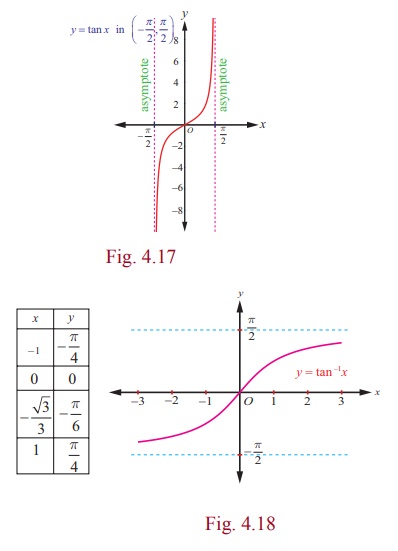
Note
(i) The inverse tangent function is strictly increasing and
continuous on the domain (-∞, ∞) .
(ii) The graph of y = tan-1x passes through the
origin.
(iii) The graph is symmetric with respect to origin and hence, y
= tan-1x is an odd function.
Example 4.8
Find the principal value of tan-1 (√3)
Solution
Let tan-1 (√3) = y .
Then, tan y = √3.
Thus, y = π/3 . Since π/3 ∈ ( - π/2 , π/2 ) .
Thus, the principal value of tan-1(√3) is π/3.
Example 4.9
Find (i) tan-1 (-√3 )
(ii) tan-1 ( tan (3π / 5))
(iii) tan (tan-1 (2019))
Solution
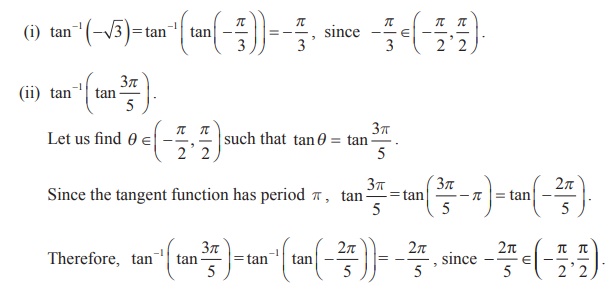
(iii) Since tan (tan-1 x) = x, x ∈
R , we have tan (tan-1 (2019)) = 2019.
Example 4.10
Find the value of tan-1 (-1) + cos-1 ( 1/2 ) + sin-1 ( - 1/2 ) .
Solution
Let tan-1 (-1) = y . Then, tan y = -1 = - tan π/4 = tan ( -
π/4 ) .
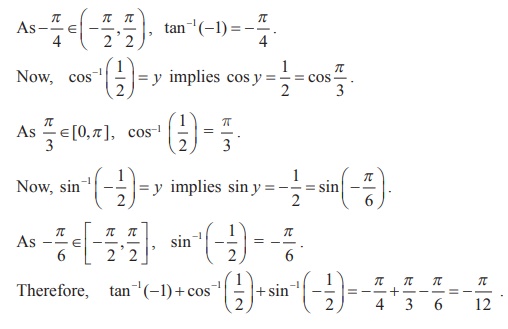
Example 4.11
Prove that tan (sin-1 x) =  , -1 < x < 1
, -1 < x < 1
Solution
If x = 0 , then both sides are equal to 0.
………..(1)
Assume that 0 < x < 1.
Let θ = sin-1 x . Then 0 < θ < π/2 . Now, sin θ = x/1 gives tanθ =  .
.
Hence, tan (sin-1x) =  ... (2)
... (2)
Assume that -1 < x < 0. Then, θ = sin-1x gives – π/2 <
θ < 0. Now, sinθ = x/1 gives tanθ = 
In this case also, tan (sin-1 x) =  ... (3)
... (3)
Equations (1), (2) and (3) establish that tan (sin-1 x) =  -1
< x < 1.
-1
< x < 1.
Related Topics